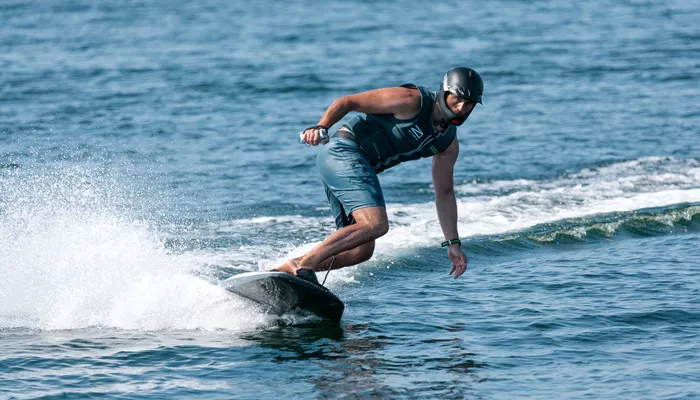Hover surfing, a futuristic blend of drone technology and extreme water sports, is redefining how we perceive surfing. Unlike traditional wave riding, hover surfing involves riding a hoverboard—a compact aerial device—over land, sea, or snow.
Inspired by sci-fi and driven by innovation, this sport combines elements of aviation, control systems, and surfing physics. For surfing beginners, understanding hover surfing opens doors to thrilling adventures beyond ocean waves.
Hover surfing represents the natural evolution of extreme sports. Using a powered platform equipped with high-thrust propellers, riders achieve low-altitude flight. It’s not science fiction anymore—it’s an accessible reality for those with courage and training. This article explores hover surfing’s principles, components, training requirements, and safety measures. Whether you’re new to surfing or an adrenaline junkie, you’ll gain insight into a sport that’s shaping the future of human mobility.
What Is Hover Surfing?
Hover surfing involves riding an electrically powered hoverboard designed for vertical takeoff and low-altitude flight. Developed by aviation engineers, these boards operate using drone-like technology but are built to carry a human pilot.
They typically use four to eight high-speed propellers, similar to a quadcopter. Unlike traditional surfing, riders don’t rely on waves—they control lift, thrust, and direction with onboard controls or remote systems.
The Inspiration Behind Hover Surfing
The concept of hover surfing draws from decades of sci-fi and engineering dreams. Films like *Back to the Future II* sparked imagination. Military research added technical substance. Hover bikes and personal air vehicles paved the way. Eventually, innovators created compact boards capable of lifting a person. The first functional hoverboards emerged from defense contractors, later transitioning into recreational prototypes.
Key Components of a Hover Surfboard
1. Propulsion System
The propulsion system includes electric motors and propellers. High RPM rotors provide lift. Placement and balance are crucial—symmetry ensures stability. Some models feature coaxial rotors for efficiency.
2. Power Source
Lithium polymer (Li-Po) batteries are the primary energy source. These batteries offer high energy density and discharge rates. Hover surfing demands considerable power—flight times typically range from 5–25 minutes, depending on weight and environmental conditions.
3. Control System
Hoverboards use gyroscopic sensors and accelerometers. These systems adjust motor speed for stability. Pilots control pitch, roll, yaw, and altitude via handheld remotes, joysticks, or onboard sensors.
4. Frame and Body
The frame consists of lightweight carbon fiber or aluminum. Durability and weight reduction are vital. Aerodynamic design enhances maneuverability. Platforms include footholds or bindings to secure the rider.
How Hover Surfing Achieves Flight
Vertical Takeoff
With propellers spinning at thousands of RPMs, lift is generated. The rider activates the throttle. Thrust must exceed the system’s total weight to rise.
Hover and Stability
Once airborne, balance becomes the key. Sensors continuously monitor orientation. Micro-adjustments keep the rider upright and level.
Directional Control
Pitch forward to move ahead, backward to slow or reverse. Yaw spins the craft. Roll allows banking. The rider leans or uses a controller to navigate.
Hover Surfing vs. Traditional Surfing
1. Environment
Traditional surfing depends on waves and tides. Hover surfing works in diverse terrains—lakes, beaches, open fields.
2. Technique
Surfing emphasizes timing and paddling. Hover surfing requires throttle control, balance, and flight awareness.
3. Accessibility
Beginners may struggle with wave timing. Hover surfing offers controlled practice settings. That makes it appealing for surfing beginners.
Training and Safety Considerations
Physical Fitness
Pilots need strong core muscles and excellent balance. Endurance and coordination are essential.
Flight Training
Operators should undergo training. Simulators and ground practice help build confidence. Novices should avoid high altitudes.
Safety Gear
Helmets, padded suits, gloves, and goggles are recommended. Some boards have parachute systems in case of power loss.
Legal Restrictions
Hover surfing is still under scrutiny in many regions. Airspace laws may limit usage. Always verify local regulations before flying.
Popular Hover Surfing Models
1. Hoversurf Scorpion-3
A pioneering model from Russia. Features motorcycle-style design and four rotors. Controlled via joystick.
2. Zapata Flyboard Air
A jet-powered version using turbines. Higher speed and altitude. Requires advanced training and licensing.
3. Omni Hoverboard
Canadian innovation. Achieved a Guinness World Record for longest hoverboard flight. Light and modular design.
Benefits of Hover Surfing
Adrenaline and Thrill
Nothing compares to human flight. Riders enjoy a rush unmatched by traditional surfing.
Mobility Freedom
No need for waves or wind. The rider controls direction, speed, and altitude at will.
Innovation Potential
Hover surfing contributes to personal transport technology. It may shape future urban mobility.
Challenges and Limitations
1. Battery Life
Short flight time limits usability. Advances in battery tech are needed for longer sessions.
2. Cost
Hoverboards are expensive—entry models start at tens of thousands of dollars. Parts and training add costs.
3. Noise and Safety
High decibel levels can disturb wildlife and people. Spinning blades pose injury risks without proper caution.
Hover Surfing in Extreme Sports Culture
Hover surfing is attracting a growing community. It blends freestyle tricks with stunt piloting. Events showcase aerial flips, spins, and low-altitude races. For those seeking more than wave surfing, it opens a new frontier. It’s especially intriguing for surfing beginners looking to bypass crowded beaches or flat tides.
Getting Started with Hover Surfing
Step 1: Learn the Basics
Read up on drone dynamics, aviation laws, and surfing techniques. Understanding flight principles is critical.
Step 2: Choose a Model
Pick a hoverboard that matches your weight, skill level, and budget. Avoid high-powered models if you’re a beginner.
Step 3: Safety First
Invest in gear. Follow certified training. Practice in controlled environments before public or open-area use.
Conclusion
Hover surfing is more than a novelty—it’s the next leap in extreme sports evolution. With drone-inspired propulsion, smart control systems, and boundless terrain access, it redefines the limits of surfing. For surfing beginners, it offers an unconventional but exhilarating path to flight. As technology evolves and safety improves, expect hover surfing to become a mainstream thrill.
Whether you’re flying above waves or soaring across fields, hover surfing turns gravity into a playground. Prepare your gear, master the controls, and take off into a new dimension of freedom.

